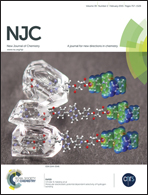Carbonyl migration from phosphorus to the metal in binuclear phosphaketenyl metal carbonyl complexes to give bridging diphosphido complexes†
Abstract
Alkali metal salts of the 2-phosphaethynolate anion PCO− synthesized from reactions of CO with NaPH2 or K3P7 have recently become available in quantities for the synthesis of transition metal complexes of the potentially ambidentate PCO ligand (Angew. Chem., Int. Ed., 2013, 38, 10064). This is exemplified by the recently reported rhenium carbonyl complex (triphos)Re(CO)2(PCO) (triphos = MeP(CH2PPh2)3). Density functional theory studies on the related manganese carbonyl complexes Mn(CO)n(PCO) (n = 5, 4, 3) and Mn2(CO)n(PCO)2 (n = 8, 7, 6, 5) are now reported. For the binuclear systems the low-energy Mn2(CO)8(PCO)2 structures are singlet spin state structures having two bridging P-bonded phosphaketenyl μ-PCO ligands without a direct Mn–Mn bond. Carbonyl loss from Mn2(CO)8(μ-PCO)2 is predicted to lead to migration of CO groups from phosphorus to manganese resulting in Mn2(CO)n+2(μ-P2) structures with bridging diphosphido groups as the lowest energy Mn2(CO)n(PCO)2 isomers (n = 7, 6, 5). Isomeric Mn2(CO)6(PCO)2 structures with dihapto bridging η2-μ-PCO ligands at ∼30 kcal mol−1 above the global minimum are also found representing intermediates in the migration of CO groups from phosphorus to manganese. For the mononuclear systems the P-bonded Mn(CO)n(PCO) (n = 5, 4) phosphaketenyl structures are found to lie 20 to 28 kcal mol−1 in energy below the isomeric O-bonded Mn(CO)n(PCO) phosphaethynoxy isomers consistent with previously reported results by Grützmacher and coworkers on R3E(PCO)–R3E(OCP) systems (R = iPr, Ph; E = Si, Sn, Ge, Pb). The lowest energy structure for the tricarbonyl Mn(CO)3(PCO) is a singlet structure with an unusual trihapto η3-PCO ligand. However, higher energy isomeric Mn(CO)3(PCO) structures with P-bonded phosphaketenyl or O-bonded phosphaethynoxy ligands and tetrahedral Mn coordination are also found.


 Please wait while we load your content...
Please wait while we load your content...